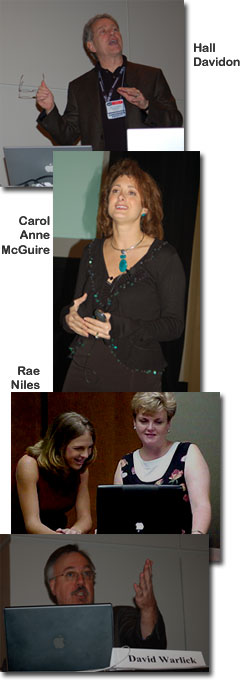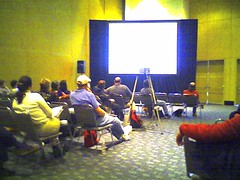If I could think of a more superlative term to describe my experience at yesterday’s K12 Market Symposium, at MacWorld, I would use it. Cheers and applauds go to Mike Lawrence, the executive director of California CUE. He and his staff coordinated the event with MacWorld, the first educator strand in many years. They had so many attendees to register for the symposium that MacWorld had to move us into a larger hall. But what blew me away was the line-up of speakers that Mike brought in.
 I started it off with a keynote. Same old thing, I’ve heard it before 😉 Then Hall Davidson, world class keynote speaker, is also a great presenter of nuts and bolts. He was his usually dynamic and very high energy self — very smart and quick. Davidson demonstrated some very basic, but compelling video production techniques. His invention, KitZu, certainly appears to have matured into something that all educators should be aware of and be using.
I started it off with a keynote. Same old thing, I’ve heard it before 😉 Then Hall Davidson, world class keynote speaker, is also a great presenter of nuts and bolts. He was his usually dynamic and very high energy self — very smart and quick. Davidson demonstrated some very basic, but compelling video production techniques. His invention, KitZu, certainly appears to have matured into something that all educators should be aware of and be using.
You go to the web site, select a subject area, and then download a kit labeled with a topic of interest. He picked sharks. After the download, you have a folder with image files, video files, and audio. These files can very easily be dragged and dropped into iMovie or Premiere on the PC, and then sequenced and voiced over to create an original video product. Kits learn, by producing something that teaches. “How cool is that?”
After lunch, I did my standard Podcasting presentation. I have to say that the jet lag had taken hold by that point, and frankly, I don’t remember much of what I said, so I hope I did good. We did record some input from the crowd, and perhaps I’ll have a podcast of that in the coming days or weeks.
That was followed by Carol Anne McGuire, whom I talked about in yesterday’s blog. I wrote during her presentation and posted it during my final session on Blogging as a demonstration. In retrospect, I think that what impressed me the most about Carol Anne’s presentation is that I expected to learn about utilizing features of computers to compensate for her students’ visual handicaps. Instead, it was about how technology made her children special.
Rae Niles told the story in her presentation about a class in one of her schools that was studying handicaps and especially blindness. There were no blind people in their small Kansas town, so the study was purely academic. But Rae knew Carol Anne, and arranged for her students to iChat into the Kansas classroom and to have the students talk together about the challenges of navigating a sighted world, and even some advantages that the blind children described.
Rae Niles, the next speaker, is a master story teller. She is the director of curriculum and technology in a 1:1 school district in Kansas. She says that the most obvious benefits of 1:1 is that attendance is up, Discipline issues are down, and the relationship between students and teachers has changed. But Rae told several stories about specific students who, before they had laptops, had been notable underachievers and a frequent source of disruption in their classrooms. But, when empowered by personal computers, their behaviors changed, their grades went up, and unique talents emerged that no one had seen before.
A few months ago, I podcasted a story that I had heard from an Apple rep at the state educational technology conference in Kansas. The story was about four boys, who interviewed a number of local residents about World War II, learning about the soldier train and how people would bring baked goods and fried chicken to Newton, Kansas, to hand to the soldiers as they rolled by on their way to the war. The four boys changed the focus of their video production in a way that illustrated that what they had learned was special, that they owned what they learned. Well, it happened in one of Rae Niles schools and she told that story yesterday. I certainly wish that I had known and could have recorded her telling. She is a unique talent that I think we’ll all be hearing a lot more of.
After closing the event with my standard blogging presentation, I thought back on the day, again thankful to Mike Lawrence for assembling such a powerful event. …And all I can think about is the tragic waste that we are allowing to happen in this country and world by not empowering all of our children to be their best. We need each other’s best right now, and we can afford to do it. We simply lack the vision and courage among our leaders. Come next November, here in the U.S., look for those characteristics in the people you vote for. We must stop looking backward, and start moving forward.
2¢ worth
 I’m listening to a web presentation produced and made available by Ewan McIntosh. I kind’a like the style of his slides, reminding me a bit of some of Lessig’s presentations. I’m not sure it’s not distracting, but I’m certified A.D.D., so who am I to judge.
I’m listening to a web presentation produced and made available by Ewan McIntosh. I kind’a like the style of his slides, reminding me a bit of some of Lessig’s presentations. I’m not sure it’s not distracting, but I’m certified A.D.D., so who am I to judge.
 I’m sitting in my first virtual conference. I know, I should be old hand at this, but I’m really an old-fashioned sort of guy. Ian Gibson, of Sidney, Australia is currently delivering the keynote address. Because his PowerPoint was too large, he is aiming his camera at his own computer display to project his slides. Using technology is about adapting.
I’m sitting in my first virtual conference. I know, I should be old hand at this, but I’m really an old-fashioned sort of guy. Ian Gibson, of Sidney, Australia is currently delivering the keynote address. Because his PowerPoint was too large, he is aiming his camera at his own computer display to project his slides. Using technology is about adapting. I started it off with a keynote. Same old thing, I’ve heard it before 😉 Then Hall Davidson, world class keynote speaker, is also a great presenter of nuts and bolts. He was his usually dynamic and very high energy self — very smart and quick. Davidson demonstrated some very basic, but compelling video production techniques. His invention,
I started it off with a keynote. Same old thing, I’ve heard it before 😉 Then Hall Davidson, world class keynote speaker, is also a great presenter of nuts and bolts. He was his usually dynamic and very high energy self — very smart and quick. Davidson demonstrated some very basic, but compelling video production techniques. His invention,  Carol Anne McGuire, Teacher, Imperial Elementary, Orange Unified School District.
Carol Anne McGuire, Teacher, Imperial Elementary, Orange Unified School District. OK, no more chocolate cake at 10:00 PM. That aside, I had a wonderful evening last night with some really smart people. Mike Lawrence, the executive director of
OK, no more chocolate cake at 10:00 PM. That aside, I had a wonderful evening last night with some really smart people. Mike Lawrence, the executive director of  Mostly in the air today, flying to San Francisco for MacWorld. Then a long nap. I’m having dinner with some really smart people tonight, so I wanted to be sharp. I don’t think I’ve managed that. Anyway, here’s a picture of the scene outside my hotel room.
Mostly in the air today, flying to San Francisco for MacWorld. Then a long nap. I’m having dinner with some really smart people tonight, so I wanted to be sharp. I don’t think I’ve managed that. Anyway, here’s a picture of the scene outside my hotel room.